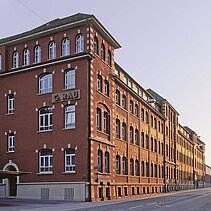Turnplatz Before 1945
Places and Buildings Before 1945
[1] 1945
After bomb-releases to Pforzheim in the war years 1944/45 and the blowing-ups by the Wehrmacht in April 1945, 17 bridges and footbridges were no more crossable in the town area and further more were extremely damaged. "Goethebrücke" was also destroyed as well as the adjoining buildings of "Reuchlingymnasium" and "Oberrealschule".
[2] 1914
The name of the "Turnplatz" reminds of Pforzheims "Turnverein" of 1834 e.V., the oldest gymnastics club of Baden. On 13th September 1863, the "Turnplatz" and the gymnasium had been inaugurated. As big halls were rare in the town, this hall was immediately used for other events. After moving the gymnastic activities to the Bohrain, the first weekly market could move in 1926 from the "Marktplatz" to the "Turnplatz".
[3] around 1912
In 1905, the prestigious "Reuchlingymnasium" was built in Neorenaissance-style at the river banks of the Enz according to plans of the state architect Heinrich Henz from Karlsruhe. This school building received a rich design with wall paintings, reliefs and colored panes of glass. In direct neighborhood, the "Oberrealschule" was inaugurated in July 1911 and named after Friedrich I., Grand Duke of Baden, and this school was the precursor of todays "Hebel-Gymnasium". The corner tower represented here an eye-catching visual feature.
[1] 1906
In December 1904 the "Goethebrücke" was opened for traffic on the "Turnplatz". The famous Jugendstil-architect Hermann Billing from Karlsruhe designed the wrought-iron railings and the four pieces of decorative candelabra. The access to the bridge was flanked by two lions and two griffins that were designed by the sculptor Fritz Wolber, professor at Pforzheims "Kunstgewerbeschule".
Turnplatz After 1945
Places and Buildings After 1945
[1] 2016
The wide company building of Doublé-factory Gustav Rau was created in 1895 as iron frame construction with ornamental exposed brickwork front. In 1911 to 1912, another storeys were added to the building and extended to the west side. In the beginning, the core business was the fabrication of Doublé-products that were processed in the jewel industry. Today, this enterprise rich in tradition manufactures products for medical technology as well as for measurement and control technology for whom exists a worldwide demand.
[2] 2016
The "Emiliensteg" was created in 1863 between "Goethestraße" and "Turnplatz" by the ironworks of Brothers Benckiser in Pforzheim. In 1904, the iron superstructure of the bridge was shifted about 300 metres upstream of the Enz. As early example of a wide-meshed lattice girder bridge, the "Emiliensteg" possesses rarity value. It was the only inner town river footbridge Pforzheims that got through the second world war.
[3] 2016
The well-known jewel factory Wellendorff was founded in 1893 by Ernst Alexander Wellendorff. This factory is popular for its patented Wellendorff-cord of gold-wire. In the year 1969, the enterprise bought the business building of the silverware- and cutlery factory Lutz & Weiss at the "Turnplatz" which was created in 1953 according to plans of the local architect Theodor Preckel and later on was extended.
[4] 1948
The gymnasium on the "Turnplatz" was destroyed in the air attack of 23rd February 1945. In April 1946, the first weekly market of the post-war period could take place on the "Turnplatz". In the background, the destroyed house ruins could be seen at the "Wilhelmshöhe".




![Black and white image: [2] The Turnplatz in 1914. - copyright:Stadtarchiv Pforzheim – Institut für Stadtgeschichte, S1-5-10-R-46](/fileadmin/_processed_/7/2/csm_S1-9-8-10r-Turnplatz-Foto-1914-Metz_Kopie_cd4b99ed0c.jpg)






![[4] 1948: The weekly market on Turmplatz. The ruins of the war-damaged houses on Wilhelmshöhe can be seen in the background. - copyright:Stadtarchiv Pforzheim – Institut für Stadtgeschichte, S1-18-2-0-G-15](/fileadmin/_processed_/1/8/csm_S1-18-2-15g-Wochenmarkt-Turnplatz-Foto-1948-Kropf_Kopie_836a95f37c.jpg)